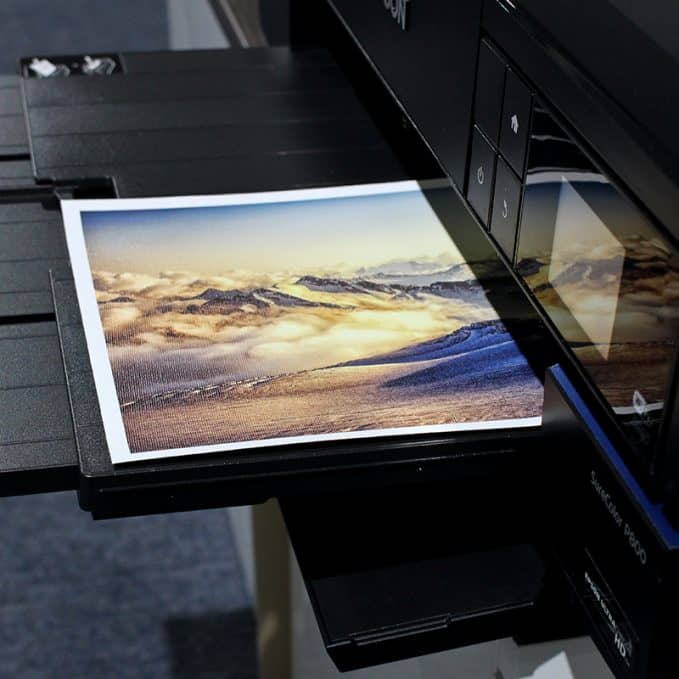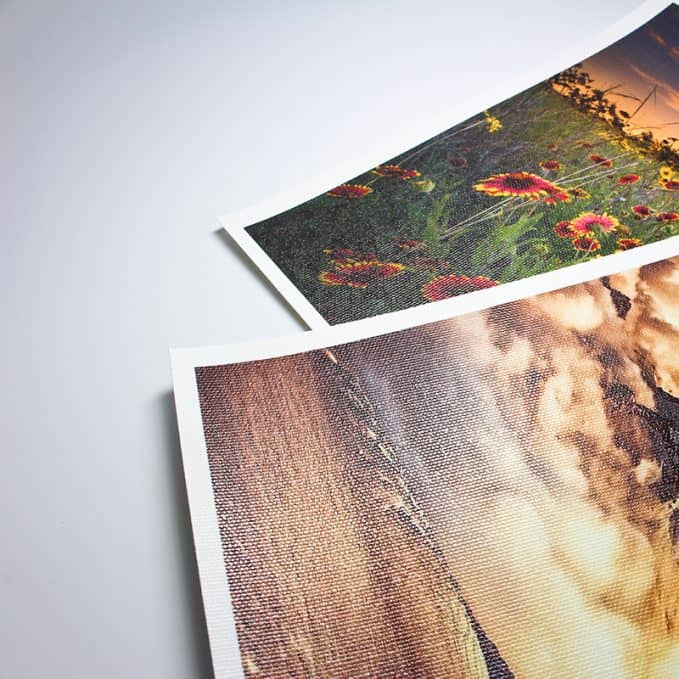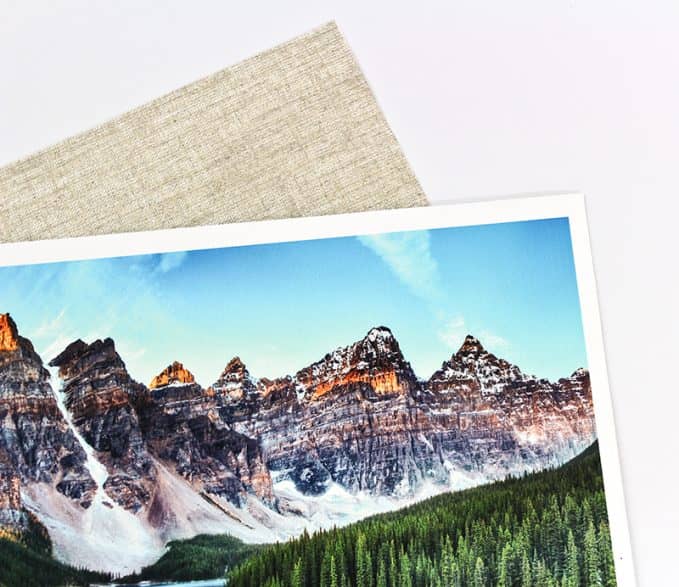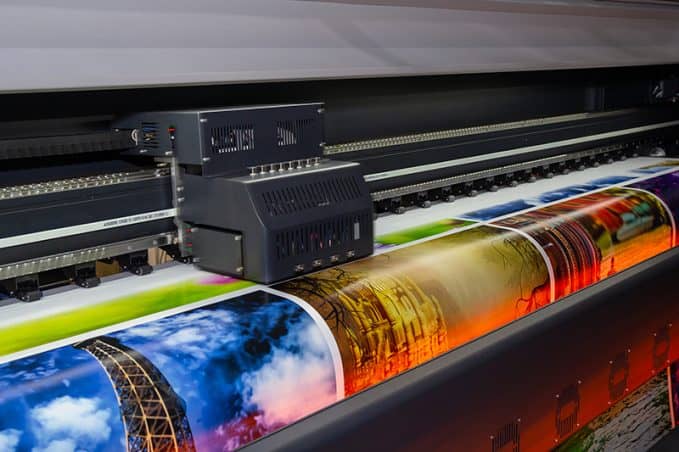Does Canon Have Art Program to Transfer Pictures to Clothing

In that location used to be a time when painting was the merely bachelor treatment for canvass surfaces. This is no longer the example. Now, you lot can create easy canvass prints at domicile with the right substrate and a adept-quality inkjet printer.

Selecting the Right Canvas Materials
Not all canvass is the same. Rather, there are different types that work well for the various projects you have in mind.
- 800M matte canvas. This material impresses with superior durability because of its 2-over-one Oxford weave. Besides that, the matte cease prevents glare from the dominicus or bogus lighting, which makes it a favorite of interior decorators. The durability besides endears information technology to set designers and those who put together decorative murals.
- 600MT matte sheet. This is a fine arts aficionado'due south favorite for imprinting. It is water-resistant, will not scuff, and does not chip. Best of all, information technology displays a slight texturing that adds certain depth to your prints.
- 17M gloss satin sail. Since there is no need to varnish the production, you tin can feed information technology right through the printer itself. It has a brilliant-white color and a satiny finish. A mix of cotton and polyester prevents creases every bit you handle the cloth and imprint it.
How to Impress on Sheet
You need an inkjet printer to get the best results. If you have a laser product, it will return cute products on paper, but information technology lacks the quality and definition that merely inkjet technology delivers to a canvass.
Adjacent, verify the printer's ability to handle the sail. Every bit y'all tin tell, the density of the sheets will exist far college than what the average sheet of newspaper brings to the tabular array. Instance in signal is a 300gsm for paper versus the 350gsm of gloss satin canvas or 405gsm of the 800M matte production. Brand a mistake hither, and you will deal with a jammed printer.
Finally, remember that y'all tin can adjust the print quality of the inkjet machine. You will notice the difference between an optimized and a standard impress when y'all await for vibrant color displays and black versus white contrast. Therefore, dial the inkjet print quality to high-resolution or photo-quality. Fifty-fifty if you are press artwork versus a photo, you lot still do good from the intricacies of the selection.
Workarounds
For some printer owners, there need to be workarounds. This is oft the case when your machine is a piddling older. For instance, you lot tin guide the printer into optimized mode when selecting high-resolution paper as your media type in some situations.
What Do Inkjet Prints on Canvas Look Like?
These products have a gallery quality. They can exist replicas of fine artworks or personal photos. Y'all can use them for commercial artwork, theatrical backdrops, or merely for home décor. Similarly, they are excellent for the types of professional artwork that you lot might sell.
What is the Best Printer for Canvas Printing?

It gets confusing when you program to impress on canvas. For starters, there are different products currently on the market. As well that, you have a number of printers to work with.
Agreement Your Canvas Options
Non all canvas is the same. Rather, manufacturers adapt the surfaces to come across the specialized needs and unique tastes of the artists who use the products.
- Lyve matte canvas. Matte surfaces are always splendid choices for the artist who prints replicas of paintings. Y'all exercise not want light reflection to take away from the color play's beauty. Similarly, y'all want to enjoy the full colour gamut too every bit deep Dmax tones.
- Silverada metallic canvas. What tin yous do with a canvas that sports a metal finish? For starters, you tin can create black and white images that have a unique visual entreatment. Besides that, they are ideal for colour displays that popular.
- 800M canvas. This is a sturdy canvas that can stand some handling. Similarly, it is ideally suited for the use equally a theatrical mural backdrop you might use in productions. That said, it is also a favorite of the commercial artist who receives a wall landscape commission that does not involve vinyl wall coverings.
- 600MT canvas. Artists choose this sail for the depth that slight texturing brings to the table. It consists of 50% cotton wool, which allows for the use in printers without fright of flaking or scuffing.
Matching the Correct Printer to Your Canvas
Inkjet engineering science is the fashion to go. Although it is tempting to go for the precision that laser press offers, it lacks the depth of the color or black and white presentation. Of form, once more, in that location are options. Y'all exercise not accept to limit yourself to just one type of inkjet model – or size.
- Roland. The Roland brand has been familiar to most artists. It keeps reinventing itself, which leads to the pattern of fantastic products that are suitable for the artist'due south studio. As you might imagine, a big format product is the right choice. Go for the 1440×720 dpi scale that provides maximum coverage and depth. As well that, at that place is the print speed to consider. If you lot run a sail print business, the Soljet EJ-640 is a high-volume car that processes 1,098 square feet of material an hour. The VersaExpress RF-640 is more docile with 521 foursquare feet an hr.
- HP. Another make that is familiar to artists is HP. The Designjet T120 large format printer is a good option when yous similar to print from the roll rather than sheets. It prints at 241.one feet and hr, which makes it a slower model. However, it makes up in color depth for what information technology lacks in speed. By far the best awarding for this printer is black and white prints.
Why It Matters What Printer Yous Pair with Your Art Canvas
Fifty-fifty though it says, "inkjet" on the documentation, non each printer works for the artist'south studio. Consider, for instance, the fact that the printer has to handle more substantial substrates. When this capability is lacking, you lot bargain with issues such as stalls and uneven processing. Therefore, spend a picayune extra time shopping carefully for the best printer for sail printing.
Which Side of Canvas Do You Print On?

How to print on sail cloth is non as straightforward as yous have been led to believe. For example, would you be able to option upward a sheet and determine which side of the sail to print on? It is not as unproblematic every bit it sounds. Here is what you need to know.
It Starts with the Selection of the Correct Canvas
- Commercial quality artwork. 17M gloss satin canvas consists of 65% polyester and 35% cotton. It is hands stretchable, which makes it suitable for a host of professional person applications. With a measurement of 350gsm, information technology may require you to select the specialized print setting on the machine.
- Replicas of historical works of art. 600MT matte sail consist of a 50% cotton fiber blend. You lot would typically use information technology for watercolor paper, which provides information technology with a slight texturing that looks excellent in a frame. It measures 300gsm, which works well with most model printers.
- Black and white prints. Silverada metallic canvas impresses with a unique finish that results in stunning finished presentations. Brand sure its 380gsm fit through your printer'south feeder.
Pick the Correct Side
Dandy, you lot think, how do I decide this? At that place is no difficult and fast rule. The quick excursion to the dissimilar types of canvases underscores that each has its own qualities. Frequently, the canvass manufacturers will add a watermark on the side that does not go printed on.
When this is not the case, lightly run your fingertips over the canvas' surface. Does it feel crude to the touch? If so, you are on the printable side if the sheet has a texture. When information technology does not accept a texture, you should pick the bright or shiny side for press. Since it is rare that both sides are exactly akin, these tips typically piece of work.
How to Print on the Right Side of the Canvas
You have identified the right type of canvas for the job. Moreover, you lot have determined the side that you will print on, what happens next?
Start with locating the manual feed slot. It is unwise to try and use the standard tray even if you use canvas sheets that fit within it. What sets apart the transmission feed slot from the tray is the ease with which you lot can pick the side you want to print on. Besides that, you tin can attach a leader strip.
This is an instrumental step in ensuring that the canvass starts feeding through the inkjet printer evenly. Because canvas is made up of fabric other than paper, this strip mimics the paper'southward edge when it starts going through the feeder tray. By the way, record the strip to the back of the paper rather than its imprintable front end.
Can You Print a Photo on Canvas?

Information technology is possible to print a photograph on canvas if you lot have the correct hardware in identify. For instance, did you know that laser printers are singularly unsuited for the task? Here is what you need to know about printing photos on canvas.
Sheet Prints with Inkjet Printers
Printers that are suitable for canvas printing have to be able to deal with the more than cumbersome substrate that the material presents. When you consider that some types of sail have texture, it is articulate that inkjet technology is the best option.
Since the average canvas weight exceeds 300gsm, look for a machine that tin can accommodate even thicker inserts. Find a model that supports manual feeder input. If you impress multiple images from a roll, this is vital. Make a mistake hither, and you lot spend a lot of your time measuring canvass and printing i by one copies.
Select the Correct Canvas for the Job
Not every canvas works for every project. Rather, yous have unlike options. Many artists favor a poly-cotton alloy. It is much easier to piece of work with than pure cotton canvas. If yous insist on using cotton, pick the high-quality kind and run a few images on blended substrates starting time to get a good feel for the way the cloth handles.
For instance, y'all might try a run with Belgian linen. It has a thickness of 425gsm, which calls for a rather bulky inkjet printer. That said, information technology provides you with gallery-style photo prints that are ideally suited for gallery wrap displays. Most importantly, information technology offers y'all the archival quality you are looking for when putting together high-quality photo prints.
If you are planning to print black and white photos, there are unlike options open to you besides. Sure, cotton fiber and linen will work simply fine. Simply for a special effect, you cannot go wrong with Silverada metal sail that measures simply 380gsm. It creates a sheen that is difficult to replicate with other means. At the aforementioned time, it makes blackness and white photos smooth – figuratively speaking.
Recollect the Leader Stripe
Many newcomers to the arts and crafts endeavour to guide their sheet through the manual feeder without any assistance. This is typically a fool'south bargain. Because printing a photo on sail ways only nearly an inch of clear space all the way around, precision is essential. This is not something that typically happens when you feed the canvas through the printer unaided.
Rather, you typically stop up with a slightly favored border that worsens as the printing continues. For smaller pieces, you lot can typically brand upward for the inconsistency. With larger ones, it becomes obvious that you missed the leader strip.
This piece attaches to the back of the canvass material and runs the length of the bottom. It mimics the edge of a piece of paper. Therefore, the machine will feed the canvas through evenly on both sides.
What Printers Can Impress on Canvass?

Artists in the know volition warn you away from light amplification by stimulated emission of radiation printers and guide you toward inkjet products. As a general rule of pollex, Epson, HP, and Roland are the principal contenders. Withal, fifty-fifty among these brands and their machines, at that place are differentiations.
Should You Invest in a Large-Format Printer?

At that place are few artists who will print photos on canvas that measure precisely viii.5-by-11 inches. Instead, they typically create larger images that are fit for framing. Although some standard desktop printers let for diverse size adjustments, you lot will do all-time with a large-format motorcar.
What to Look for in a Canvas Printer

A printer that can print on canvas needs to exist able to handle thicker substrates. Consider the dissimilar sail styles that you might use.
- 800M matte. Measuring 405gsm, information technology is a poly-cotton fiber blend that often comes in rolls measuring 64"x40'. You cut off the amount of substrate you want to use unless the machine lets you mount the gyre straight for uninterrupted printing.
- Belgian linen. Considered by many the Rolls Royce of materials, it comes in with 425gsm, which makes it ane of the more substantial canvas products you might feed through the machine. Therefore, it is essential that your printer tin bargain with this thickness.
- Chromata white canvas. Weighing in at 450gsm, it is one of the thickest sheet items you might exist using. Artists who impress photos on inkjet printers typically favor this material for its tremendous item display.
- 17M gloss satin sail. This product is on the slimmer terminate of things. Information technology weighs in at 350gsm, which puts it shut to the standard 300gsm effigy that most printers can handle. Ensure that a machine that excels at the beefier substrates also does well with the daintier ones.
What Ink Does Your Machine Use?

If it uses water-based dyes, there is a good chance that your image will undergo some changes you will non appreciate. For your artwork, information technology pays to invest in paint-based dyes that are waterproof. Virtually of these products do non fade with UV exposure, which is vital when y'all want your artwork to last past the turn of the decade or century.
Do Speed and Resolution Affair?
Some say that speed and resolution are personal preferences. Pointing to the fact that y'all typically await at artwork from a altitude away, they justify their supposition. We disagree. Yous, as the artist, know what y'all are looking at. You can tell if the product looks overly pixilated at close range. Opt for a 1440×720 dpi resolution that you lot tin can dial down if you so desire.
Speed is a thing of personal preference. Still, consider what your typical print book looks like, and and so decide if you desire to take an output of 1,098 sqft/hr. or 521 sqft/60 minutes. Since you pay for this extra feature, it makes sense to discover a happy medium if necessary.
Follow-Up Reading
If you liked this post, you'll honey these related ones:
Source: https://blog.breathingcolor.com/can-you-print-on-canvas-with-an-inkjet-printer/

0 Response to "Does Canon Have Art Program to Transfer Pictures to Clothing"
Post a Comment